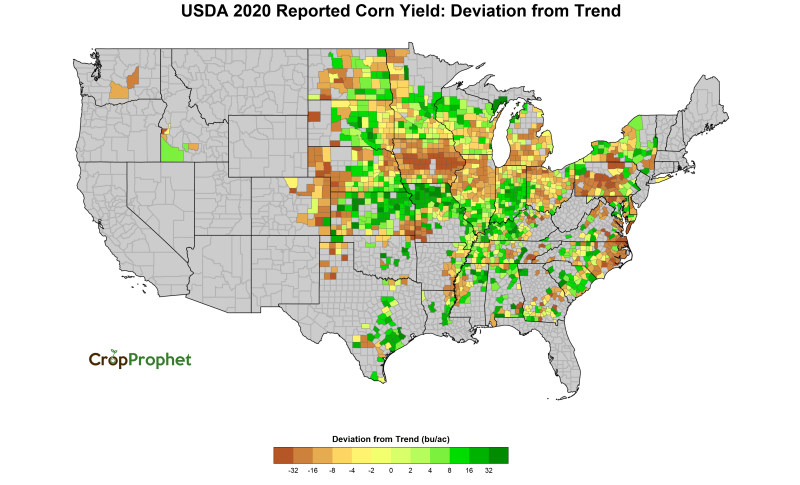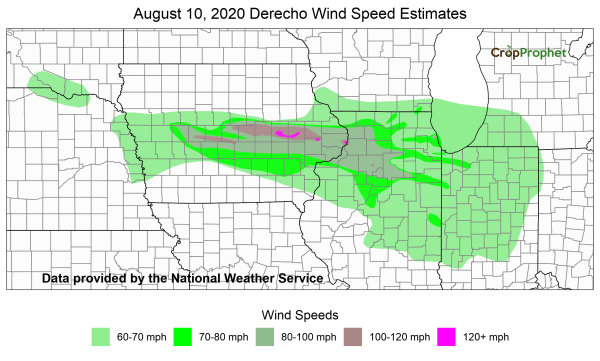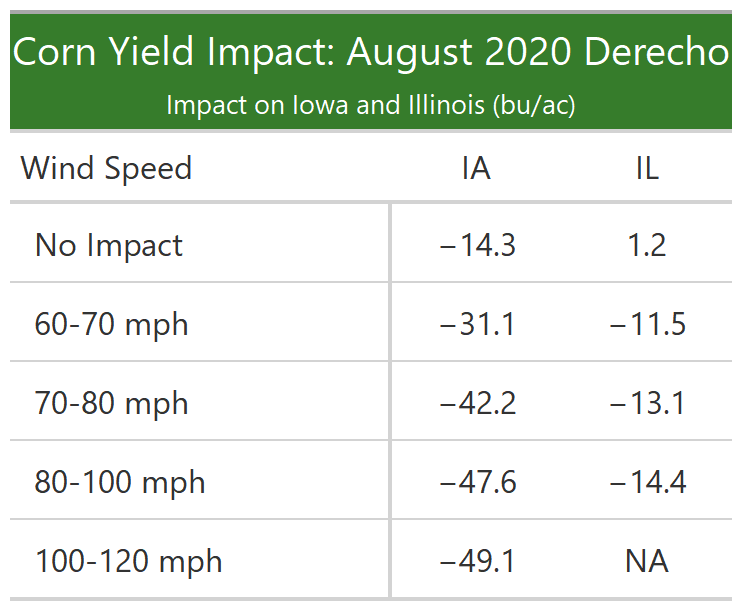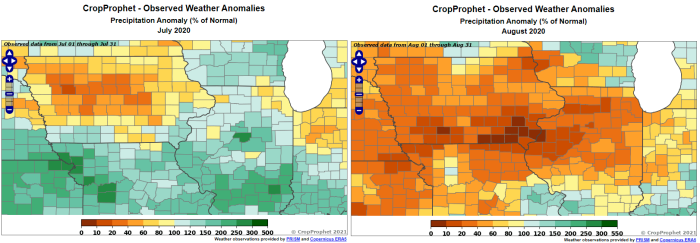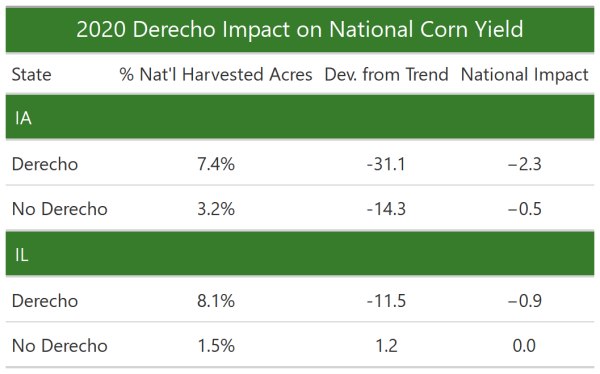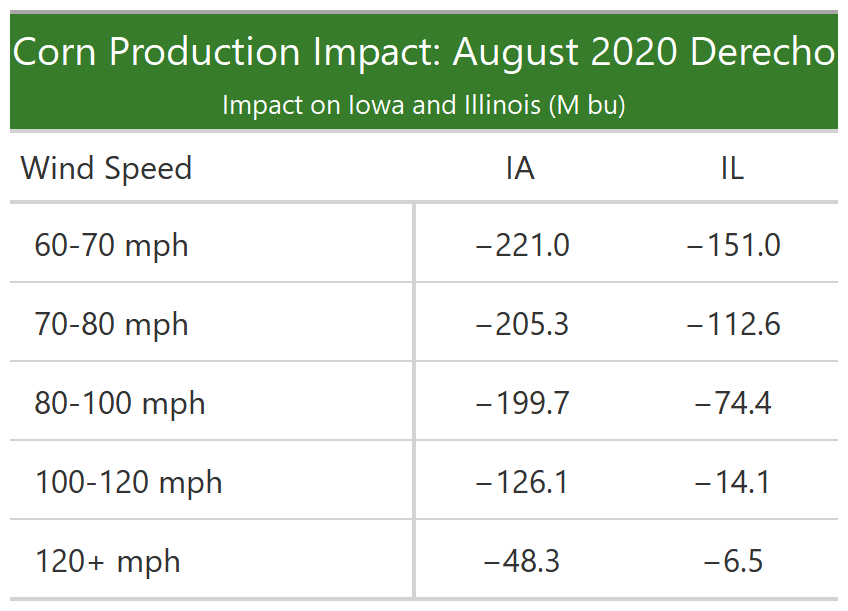Introduction
On January 12, 2021, the USDA released its 2020 end-of-season national corn yield estimate of 172.0 bu/acre, lowering the stocks-to-use ratio and supporting continued bullish sentiment in grain trading markets. What was the contribution of 2020 Iowa derecho damage to the US corn yield?
The CropProphet 2020 technology trend estimate for corn is 178.3 bu/ac. Therefore, the USDA national corn yield estimate was 6.3 bu/ac below the technology trend, the second-largest deviation from the trend since the drought year of 2012.
The USDA February 2021 release of final estimate county-level corn yield data allows us to examine the most significant weather impacts on the 2020 crop: the August 10, 2020, Iowa derecho.
The county-level corn yield deviation from the technology trend is shown below and indicates substantial yield shortfalls for many counties in Iowa and northern Illinois.

Iowa Derecho: August 10, 2020
The derecho swept through Iowa and northern Illinois from west to east during the day on August 10, 2020. Many counties experienced wind speeds of at least 60 mph, but wind speeds in some isolated areas are estimated to have exceeded 120 mph. Using data provided by the National Weather Service, the graphic below depicts the range of peak wind speeds affecting counties across the Midwest.
Shortly after the Iowa derecho event, CropProphet estimated the likely impact of the derecho on US corn production.
With US county yield and production data for 2020 now available, we can better estimate the Iowa derecho damage caused to national corn yield.
2020 Iowa Derecho Impact on Corn Yield
The regions of high wind speed shown above allow us to calculate the derecho’s impact on national corn yields more explicitly. The graphic below overlays the NWS derecho wind speed estimate with the county deviation from the trend.
It is evident that the counties in central Iowa with the most significant deviation from technology trends closely align with the regions that experienced wind speeds greater than 80 mph. A few counties reported corn yield deviations below -80 bu/ac.
Iowa Derecho Damage Estimate
This data enables grouping counties by wind speed to measure the impact of the derecho in Iowa and Illinois.
The 60-70 mph wind speed category encompasses all counties impacted by the derecho and represents each state’s overall corn yield impact. All counties inside the 60-70 mph contour experienced an average corn yield decline relative to the technology trend of -31.1 bu/ac in Iowa and -11.5 bu/ac in Illinois.
This estimate assumes the yield in both states would have been equal to the technology trend had there been no derecho. That is a wrong assumption. For example, Iowa counties unaffected by derecho averaged almost -13 bu/ac below the technology trend. Iowa experienced a regional but fairly intense drought throughout the season, contributing to lower corn yields in the state.
Iowa was drier than normal in July 2020, and Illinois was drier than normal in August 2020. These drought-like conditions undoubtedly also negatively impacted corn yield.
To address this, the “No Impact” category provides the deviation from trend values averaged over counties impacted by the derecho in each state. This can be considered the baseline yield estimate by which to compare the impact of the derecho. It is calculated using neighboring counties in their respective state to the derecho-impacted counties.
Derecho Impact on National Corn Yield
The next step estimates the derecho’s impact on the national corn yield. The table above shows the corn yield impact in derecho-impacted counties. We calculate the deviation from the technology trend in counties with no derecho damage, as shown below.
The table also shows the harvested acres compared to the total national acres for Iowa and Illinois counties, both impacted and unimpacted by the derecho. In Iowa, derecho-impacted counties contribute an average of 7.4% of the US total corn acres. Likewise, Illinois derecho-effected counties contribute 8.1% of national corn production.
The impact of the August 2020 derecho on national yield is -2.3 bu/ac for Iowa and -0.9 bu/ac for Illinois. Therefore, the total derecho damage on US national corn yield is -3.2 bu/ac without considering other factors.
We have to consider what the “baseline” corn yield would have been without a derecho. As discussed above, this is calculated using the yield deviation from neighboring counties, which allows us to adjust the estimate of the derecho’s direct impact on national yield. We subtract the harvested acres weighted “non-impacted” counties’ average technology trend from the previous estimate to do this.
So,
The Iowa derecho impact is -2.3 – (-0.5) = -1.7 bu/ac.
The Illinois derecho impact is -0.9 – 0.0 = -0.9 bu/ac.
The derecho’s impact on the national corn yield is -1.7 + -0.9 or -2.6 bu/ac. The damage caused by the 2020 Iowa derecho is less than half of the -6.3 bu/ac U.S. corn national deviation from trend.

Derecho’s Impact on Production
Using the same information, we can estimate the impact of the derecho on production. However, we can’t estimate a baseline production estimate. This method, therefore, overestimates the impact on corn production.
The production impact is estimated by measuring the 2020 final county production values from the production technology trend for each county. The 60-70 mph category is the largest area and encompasses all affected counties. The estimate of the damage caused by the Iowa derecho on national production was that it was reduced by approximately 372 M bushels.
Recall that in our September 2020 post estimating the Iowa derecho damage, we stated, “If this estimate is correct, it implies a production loss of about 175-350 million bushels (Mb) in Iowa alone.” As stated above, this production damage estimate is likely high because we calculate relative to the production technology trend. Our initial estimate ended up being accurate.
Request your trial of CropProphet today.
